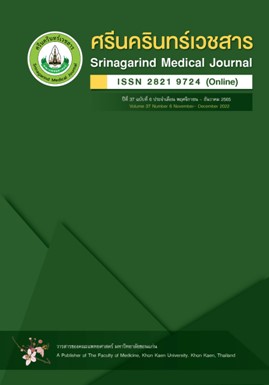ความแม่นยำในการใช้เครื่องวัดความอิ่มตัวของออกซิเจนในเลือดเพื่อคัดกรองโรคหัวใจพิการแต่กำเนิดชนิดรุนแรงในทารกแรกเกิด ที่จังหวัดบุรีรัมย์ระหว่างปี พ.ศ. 2561-2564
Abstract
หลักการและวัตถุประสงค์ : โรคหัวใจพิการแต่กำเนิดชนิดรุนแรงมีอัตราการเสียชีวิตสูง จึงมีการตรวจคัดกรองโดยการใช้เครื่องวัดความอิ่มตัวของออกซิเจนในเลือดตรวจทารกหลังคลอดทุกรายที่อายุ 24 ชั่วโมงถึงก่อนกลับบ้าน แต่การคัดกรองมีค่าความไวและความจำเพาะที่แตกต่างกันขึ้นกับประชากรที่ศึกษา การศึกษานี้มีวัตถุประสงค์เพื่อศึกษาความแม่นยำในการใช้เครื่องวัดความอิ่มตัวของออกซิเจนในเลือดเพื่อคัดกรองโรคหัวใจพิการแต่กำเนิดชนิดรุนแรงในทารกแรกเกิดที่จังหวัดบุรีรัมย์ ร่วมกับศึกษาอุบัติการณ์ ลักษณะพื้นฐานและอาการแสดงของผู้ป่วย
วิธีการศึกษา: การศึกษาเชิงพรรณนาแบบ multicenter prospective diagnostic accuracy research ในทารกแรกเกิดทุกรายที่คลอดในจังหวัดบุรีรัมย์ระหว่างวันที่ 1 มิถุนายน พ.ศ.2561 ถึง 31 กรกฎาคม พ.ศ. 2564 และได้รับการตรวจคัดกรองโรคหัวใจพิการแต่กำเนิดชนิดรุนแรง ที่อายุมากกว่า 24 ชั่วโมงถึงก่อนกลับบ้าน คำนวณทางสถิติหาค่า Sensitivity, specificity, accuracy, positive predictive value, negative predictive value, positive Likelihood ratio, negative predictive value, percentage ของการตรวจคัดกรอง
ผลการศึกษา : อุบัติการณ์ของโรคหัวใจพิการแต่กำเนิดชนิดรุนแรงในจังหวัดบุรีรัมย์เท่ากับ 1.6 ต่อ 1,000 การเกิดมีชีพ การคัดกรองมีค่า sensitivity ร้อยละ 15.0, specificity ร้อยละ 99.9 , accuracy ร้อยละ 99.9 , positive predictive value ร้อยละ 37.5 , negative predictive value ร้อยละ 99.5, positive Likelihood ratio 1,023.7 และ negative Likelihood ratio 0.9 มีผู้ป่วย 33 ราย(ร้อยละ 62.3) ได้รับการวินิจฉัยจากอาการทางคลินิกก่อนการตรวจคัดกรอง และมีผู้ป่วย 17 ราย (ร้อยละ 32.1) ได้รับการวินิจฉัยในภายหลังแม้การตรวจคัดกรองให้ผลเป็นลบ โดยในผู้ป่วยโรคหัวใจพิการแต่กำเนิดชนิดรุนแรงมีอาการแสดงที่สำคัญคือ เสียงหัวใจผิดปกติ (ร้อยละ 64.1), เขียว (ร้อยละ 60.4), หายใจเร็ว (ร้อยละ 56.6) และช็อค (ร้อยละ 11.3) ผู้ป่วยเสียชีวิต 19 ราย(ร้อยละ 35.8) โดย 11 ราย (ร้อยละ 20.1) ได้รับการวินิจฉัยก่อนการตรวจคัดกรองและ 8 ราย (ร้อยละ 15.1)ได้รับการวินิจฉัยภายหลังการตรวจคัดกรอง อัตราเสียชีวิตของทารกแรกเกิดคิดเป็น 0.6 ต่อ 1,000 ทารกเกิดมีชีพ
สรุป : การตรวจคัดกรองยังไม่แม่นยำพอที่จะแยกทารกที่เป็นโรคหัวใจพิการแต่กำเนิดชนิดรุนแรงออกจากทารกปกติได้ บุคลากรทางการแพทย์ควรระมัดระวังในการแปลผลการตรวจ และฝึกทักษะในการสังเกตความผิดปกติทางคลินิกที่พบร่วมกับโรคหัวใจพิการแต่กำเนิดเพื่อให้ผู้ป่วยได้รับการวินิจฉัยได้อย่างทันท่วงที
Accuracy of Pulse Oximetry Screening for Critical Congenital Heart Defects after birth in Buriram during 2018-2021
Katenipa Sinsupan
Pediatric cardiologist Buriram hospital
Background and Objective: Critical congenital heart disease has a high mortality rate. Therefore, a screening test was done by using a pulse oximetry to measure oxygen saturation in all infants within 24 hours to before discharge from hospital. The pulse oximetry screening had various sensitivity and specificity, depended on the studied populations. This study aimed to determine an accuracy of pulse oximetry for screening critical congenital heart disease in newborns in Buriram province and to find out the incidence and the clinical characteristics and symptoms of critical congenital heart disease patients.
Methods: Descriptive multicenter prospective diagnostic accuracy research study in the infants born in Buriram province between 1st June 2018- 31st July 2021, who were performed a pulse oximetry screening for critical congenital heart disease within 24 hours prior to discharge. Sensitivity, specificity, accuracy, positive predictive value, negative predictive value, positive likelihood ratio, negative likelihood ratio, percentage for the diagnosis of critical congenital heart disease were analyzed.
Results: The incidence of critical congenital heart disease was 1.6 per 1,000 live births. Pulse oximetry screening had sensitivity of 15.0 %, Specificity of 99.9%, accuracy of 99.9%, positive predictive value of 37.5%, and negative predictive value of 99.5% , positive likelihood ratio 1,023.7 and negative likelihood ratio 0.9. Thirty-three patients (62.3%) were clinically diagnosed before the pulse oximetry screening was performed, and 17 patients (32.1%) were later diagnosed despite the negative screening result. In patients with critical congenital heart disease, the clinical signs that were detected including heart murmur (64.1%), cyanosis (60.4%), tachypnea (56.6%), and shock (11.3%). There were 19 patients died (35.8%), of which 11 (20.1%) were diagnosed prior to the screening test, and 8 (15.1%) were diagnosed after the screening test. Neonatal mortality rate was 0.6 : 1,000 live births.
Conclusions: Pulse oximetry screening is low sensitive but highly specific to detect the patients. Conversely the screening test can not discrimination the patient with critical congenital heart disease from healthy infants. Therefore, medical personnel should closely observe clinical abnormalities that commonly found in critical congenital heart disease infants to promptly diagnose the disease.


